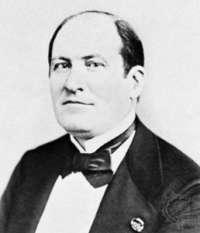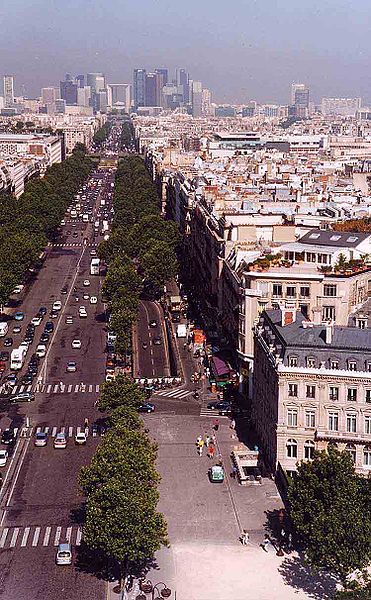<Back to Index>
- Physicist Wilhelm Conrad Röntgen, 1845
- Civil Planner Georges-Eugène Haussmann, 1809
- Prime Minister of Japan Eisaku Satō, 1901


Georges-Eugène Haussmann (27 March 1809 – 11 January 1891), who called himself Baron Haussmann, was a French civic planner whose name is associated with the rebuilding of Paris. He was born in Paris to a Protestant family from Alsace.
The son of Nicolas Valentin Haussmann, a merchant, was born in Paris and educated at the College Henri IV and subsequently studied law, attending concurrently the classes at the Paris conservatory of music, for he was a good musician. He became sous-préfet of Nérac in 1830, and advanced rapidly in the civil service until in 1853 he was chosen by Persigny prefect of the Seine département in succession to Jean Jacques Berger, who hesitated to incur the vast expenses of the imperial schemes for the embellishment of Paris. Haussmann would remain in this post until 1870.
Commissioned by Napoleon III to instigate a program of planning reforms in Paris, Haussmann laid out the Bois de Boulogne, and made extensive improvements in the smaller parks. The gardens of the Luxembourg Palace (Luxembourg Garden) were cut down to allow of the formation of new streets, and the Boulevard de Sebastopol, the southern half of which is now the Boulevard St Michel, was driven through a populous district. Additionaly, sweeping changes made wide "boulevards" of hitherto narrow streets. A new water supply, a gigantic system of sewers, new bridges, the opera house, and other public buildings, the inclusion of outlying districts - these were among the new prefect's achievements, accomplished by the aid of a bold handling of the public funds which called forth Jules Ferry's indictment, Les Comptes fantastiques de Haussmann, in 1867 (a play on words between contes, stories or tales - as in Les contes d'Hoffmann or Tales of Hoffmann, and comptes, accounts.)
A loan of 250 million francs was sanctioned for the city of Paris in 1865, and another of 260 million in 1869. These sums represented only part of his financial schemes, which led to his dismissal by the government of Émile Ollivier. After the fall of the Empire he spent about a year abroad, but he re-entered public life in 1877, when he became Bonapartist deputy for Ajaccio.
His work had destroyed much of the medieval city. It is estimated that he transformed 60% of Paris' buildings. Notably, he redesigned the Place de l'Étoile, and created long avenues giving perspectives on monuments such as the Arc de Triomphe and the Opera Garnier.
Haussmann had been made senator in 1857, member of the Academy of Fine Arts in 1867, and grand cross of the Legion of Honour in 1862. He died in Paris and is buried in Le Cimetière Père Lachaise, Paris. His name is preserved in the Boulevard Haussmann. His later years were occupied with the preparation of his Mémoires (3 vols., 1890-1893).
According to his memoirs, Haussmann's use of the title baron was based on his elevation to the Senate and to an 1857 decree of the emperor's that gave Senate members the title of baron; his memoirs further stated that he joked that he might consider the title aqueduc, (a pun on the French words for 'duke' and 'aqueduct') but that no such title existed. However, the Dictionary of the Second Empire states that Haussmann used the title of baron casually, out of pride as the only male descendant of his maternal grandfather, Georges Frédéric, Baron Dentzel, a general under the first Napoleon. This use of baron, however, was not official, and he remained, legally, merely Monsieur Haussmann.
Between the Revolution of 1789 and Haussmann's renovation of Paris in
the 1860s, ideals changed from those of a politically motivated city to
those of an economically and socially centered city. Modern technology
such as railroads and gas lamps were conveniences which the rising
bourgeoisie could enjoy in their leisurely lifestyle. New spaces that
were created during the renovation encouraged the bourgeoisie to flaunt
their new wealth, creating a booming economy. All of these examples of
the changes occurring in Paris during this time period can be seen in
representations of the city. There are two views of Baron Haussmann:
One depicts him as the man who destroyed Old Paris, and the other as
the man who created New Paris. Georges-Eugène
Haussmann was hired by Napoleon III on 22 June 1852 to "modernize"
Paris. He hoped in hiring Haussmann that Paris could be moulded into a
city with safer streets, better housing, more sanitary, hospitable,
shopper-friendly communities, better traffic flow, and, last but not
least, streets too broad for rebels to build barricades across them and where coherent battalions and artillery could circulate easily if need be. He
created broad avenues linked to the main train-stations so army troops
from the provinces could be operative in a short amount of time (for
example, the boulevard de Strasbourg near Gare de l'Est and Gare du Nord). This work achieved during the Second Empire is one of the causes of the quick repression of the 1871 Paris Commune: since the 1848 revolution, Adolphe Thiers had
become obsessed with crushing out the next foreseeable Parisian
rebellion. Thus, he planned to leave the city and retreat, in order to
better take it back with more military forces. Haussmann's
design of streets and avenues, combined with the new importance given
to trains, made this plan more than successful, and Adolphe Thiers easily crushed the Communards.
Haussmann accomplished much of this by tearing up many of the old,
twisting streets and rundown apartment houses, and replacing them with
the wide, tree-lined boulevards and expansive gardens for which Paris
is famous today. Other elements of Haussman's plan included uniform
building heights, grand boulevards, and anchoring elements including
the Arc de Triomphe and the Grand Opera House. Haussmann's plan for Paris inspired some of the most important architectural movements including the City Beautiful Movement in the United States. In fact, renowned American architect Daniel Burnham borrowed liberally from Haussmann's plan and even incorporated the diagonal street designs in his 1909 Plan of Chicago. Cities like London and Moscow also have Haussmann influences in their city plans. Haussmann's
plans, with their radical redevelopment, coincided with the 1860s - a
time of intense political activity in Paris. Many Parisians were
troubled by the destruction of "old roots". Historian Robert Herbert says that "the impressionist movement depicted this loss of connection in such paintings as Manet's Bar at Folies."
The subject of the painting is talking to a man, seen in the mirror
behind her, but seems unengaged. According to Herbert, this is a
symptom of living in Paris at this time: the citizens became detached
from one another. "The continuous destruction of physical Paris led to
a destruction of social Paris as well." Haussmann was also criticized
for the great cost of his project. Napoléon III fired Haussmann
on 5 January 1870 in order to improve his own flagging popularity.
Haussmann was also a favorite target of the Situationist's critique; besides pointing out the repressive aims that were achieved by Haussmann's urbanism, Guy Debord and his friends (who considered urbanism to be a "state science" or inherently "capitalist" science) also underlined that he nicely separated leisure areas from work places, thus announcing modern functionalism, as illustrated by Le Corbusier's precise zone tripartition (one zone for circulation, another one for accommodations, and the last one for labour). The changes wrought by Haussmann on the streetscape of Paris were documented in the film, Paris: Living Space, featuring Edmund N. Bacon and based on sections of his book Design of Cities.